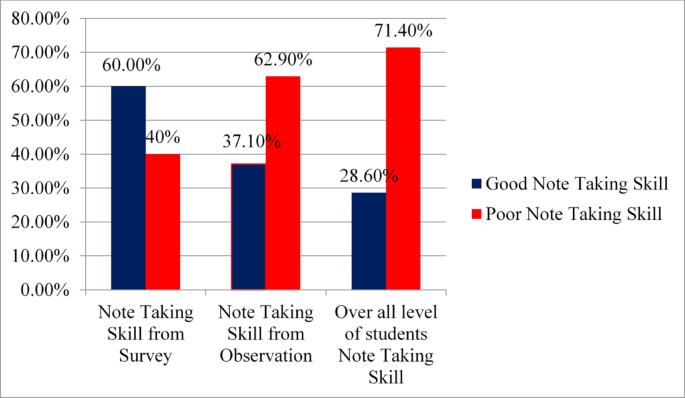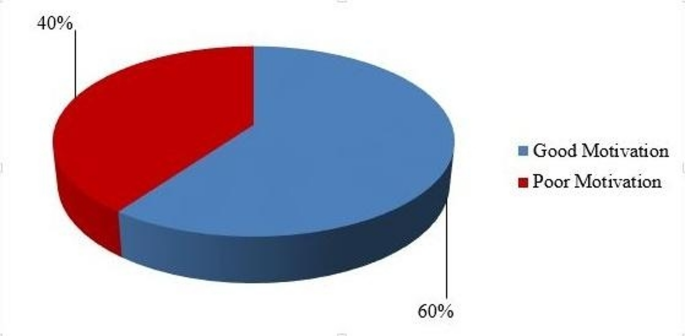Strengthening academic and clinical performance through structured note-taking: an action research study in nursing education | BMC Research Notes

The study involved a total of 35 nursing students with a mean age of 22.94 years (SD = 1.924), ranging from 20 to 26 years. Of the participants, 6 were male and 29 were female, reflecting the gender distribution commonly observed in nursing education. In terms of academic level, 20 students were in their third year, while 15 were fourth-year students, ensuring representation across advanced clinical stages. Notably, 8 students had previously participated in structured note-taking training, which provided an important context for assessing variations in learning behavior and academic engagement.
Structured note-taking skill result
Out of the total participants, 21 students (60%) scored above the group mean on the survey, and 13 students (37.1%) met ≥ 5 of the 7 observational criteria, qualifying individually as having Good Note-Taking Skills. However, when applying the composite criteria scoring above the mean on the survey and meeting ≥ 5 observational benchmarks simultaneously only 10 students (28.6%) demonstrated Good Note-Taking Skills prior to the intervention, as illustrated in (Fig. 2) below.

Distribution of note taking skill of 3rd and 4th year nursing students, Wollega University, Western Oromia, Ethiopia, 2023
These findings were further enriched through qualitative insights from Focus Group Discussions (FGDs) with students and in-depth interviews with instructors, revealing underlying gaps and contextual influences. Students’ Note-Taking Practices are largely informal, inconsistent, and lack structure, though many expressed a desire to improve. Contextual Factors like fast-paced rounds, workload, and instructor support greatly influence note-taking effectiveness. Major Challenges include time pressure, cognitive overload, unfamiliar medical terms, and lack of formal training on clinical note-taking. Instructors Observed wide variability in note organization, with most students using unsystematic methods. A few demonstrated effective personal strategies such as outlines or concept maps.
Students motivation results
The average motivation score among participants was 4.42 (± 0.83), with scores ranging from 1 to 4. Approximately 21 students (60%) scored above the group mean, indicating relatively higher motivation levels. However, a closer look at specific items assessing motivation reveals concerning trends: 22 students (62.9%) reported never feeling motivated to take notes during lectures, 19 (48.6%) were never motivated to take notes during clinical rounds, 20 (57.1%) felt their notes did not help them understand or recall clinical content, and 17 students (48.6%) did not feel motivated to review or use their notes for exams or case presentations. The finding on the level of motivation reveals 14(40%) have poor motivation and 21(60%) have good motivation for learning in the classroom (Fig. 3).

Distribution of motivation status of 3rd and 4th year nursing students, Wollega University, Ethiopia, 2023
Perceived student performance and note-taking practices results
The quantitative results revealed that only 40% of students scored at or above the group mean (2.37 ± 0.97), indicating a moderate level of perceived academic performance. This aligns with qualitative insights from both students and instructors, who highlighted inconsistent, informal, and often unstructured note-taking practices.
From students’ FGDs
Many students admitted to using random or memory-based note-taking methods, which hindered both academic review and clinical application. Challenges such as time constraints, cognitive overload, lack of formal training, and limited exposure to structured formats (e.g., SOAP, K_SOAP, and SBAR) were common. However, students recognized the academic benefits of well-organized notes, citing their importance for exam preparation, care plans, and confidence in clinical reasoning.
From instructors’ perspectives
Faculty consistently observed wide variability in note organization and emphasized that students with structured notes demonstrated stronger clinical reasoning, communication, and participation. Instructors noted that while structured tools improved documentation quality and student confidence, their effectiveness depended heavily on training, mentoring, and consistent practice.
Paired samples test result
A paired samples t-test was conducted to examine the change in students’ composite level of note-taking skills (measured through both survey scores and observational checklists) before and after the intervention. The analysis revealed a statistically significant improvement in note-taking skills following the intervention. The mean difference between pre- and post-intervention scores was − 0.60 (SD = 0.61), with a standard error of the mean = 0.10. The 95% Confidence Interval for the difference ranged from − 0.81 to -0.39. The t-value was − 5.88 with 34 degrees of freedom, and the result was statistically significant (p < 0.0001) (Table 1).
Action Plan for Enhancing Note-Taking Skills
The action plan for improving note-taking skills among 3rd and 4th-year nursing students at Wollega University, Ethiopia (2023), outlines a six-phase approach. It begins with assessing current practices, followed by training on various note-taking methods. Workshops and real-time clinical practice support students, with ongoing mentoring and peer-learning. Post-intervention evaluations measure progress, and the plan concludes with integrating these practices into the curriculum for long-term sustainability (Table 2).
A multi-method, triangulated approach was employed to ensure robust data collection and validation. The methodology integrated quantitative and qualitative instruments: Quantitative Surveys captured demographics, self-reported skill proficiency, motivation levels, and perceived academic performance. Direct Observation provided objective skill assessment against validated criteria. Qualitative Insights from focus groups and instructor interviews revealed underlying challenges and contextual factors. Statistical Analysis (paired t-test) quantitatively measured the intervention’s efficacy (Table 3).
link






